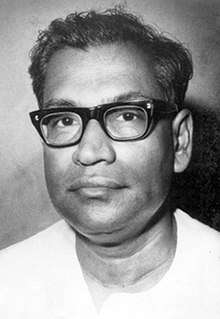Narendranath Mitra
Narendranath Mitra (30 January 1917 – 14 September 1975) was an Indian writer and poet, best known for his short stories in the Bengali-language.[1][2]
Narendranath Mitra | |
|---|---|
 | |
| Born | 30 January 1917 Sadardi, Faridpur, Bengal Presidency, British India (now in Bangladesh) |
| Died | 14 September 1975 Kolkata, India |
| Occupation | Writer, Journalist and novelist |
| Language | Bengali |
| Nationality | Indian |
| Citizenship | Indian |
| Alma mater | Bangabasi College, University of Calcutta |
| Notable works | Chenamahal |
Biography
He was born in Faridpur in modern-day Bangladesh.[1] He was based in Kolkata, now in India at the time of partition in 1947, and chose to remain in India when his birthplace fell to the share of East Pakistan.[3]
In 1933, passed S. S. C. Level from Vanga High School obtaining first division marks. I. A. from Rajendra College, B. A. from Bangabasi College, of the University of Calcutta.
He found employment at the Dum Dum ordnance factory in Kolkata during the Second World War. After that, he joined Kolkata National Bank. Later, his family was living in Kolkata.
He was a journalist, editor; worked for 'Krishok', 'Swaraj' 'Satyajug'. From 1951 to 1975, was with Anandabazar Patrika.
Works adaptations
His story Abataranika was adapted into Mahanagar (The Big City) by Satyajit Ray in 1964, with Madhabi Mukherjee as lead. Ras(রস) was adapted into the Hindi film, Saudagar (1973), by Sudhendu Roy, starring Amitabh Bachchan and Nutan;[4] and a Bangladeshi film Poush Maser Pirit by Nargis Akhter, starring Ahmed Rubel and Sadika Parvin Popy.[5] In 1975 a Bengali film Palanka was released based on his short story. 1988 Bengali film, Phera by Buddhadeb Dasgupta, was also adapted from his story.
Bibliography
- Deeppunjo
- Osomotol
- Holde Bari
- Dehomon
- Durvashini
- Rupmonjori
- Ultoroth
- Sukh Dukher Dheu
- Suklapakhya
- Chenamahal
- Chorai Utrai
- Okhore Okhore
- Jatrapath
- Misrarag
- Headmaster
- Mohanagar
- Chilekotha
- Shandhyarag
- Surjasakkhi
- Sreshtha Golpo
- Tin Din Tin Ratri
- Suryasakshi
- Godhuli
- Chhatri
- Debjan
- Bilambitalay
References
- Mofiz Imam Milon (30 January 2016). "নরেন্দ্রনাথ মিত্র :ছোটগল্পের বড় লেখক" [Narendranath Mitra: Great Writer of Short Stories]. The Daily Ittefaq (in Bengali).
- "বিষণ্ণ এক অক্ষরপুরুষ" [Writing the Colourful Life of Writer Narendranath Mitra]. Anandabazar Patrika (in Bengali).
- Tuhin Wadud (1 April 2016). "কালোত্তীর্ণ গল্পকার নরেন্দ্রনাথ মিত্র" [Narendranath Mitra, a Blackened Storyteller]. Bangladesh Pratidin (in Bengali).
- Gulzar; Govind Nihalani; Saibal Chatterjee (2003). Encyclopaedia of Hindi Cinema. Encyclopedia Britannica. p. 337. ISBN 978-81-7991-066-5.
- "Making Movies for a Cause". The Daily Star. 1 July 2010. Retrieved 14 December 2018.
External links
- Narendranath Mitra on IMDb
- Works by Narendranath Mitra at Open Library
- Narendranath Mitra at the West Bengal Public Library Network